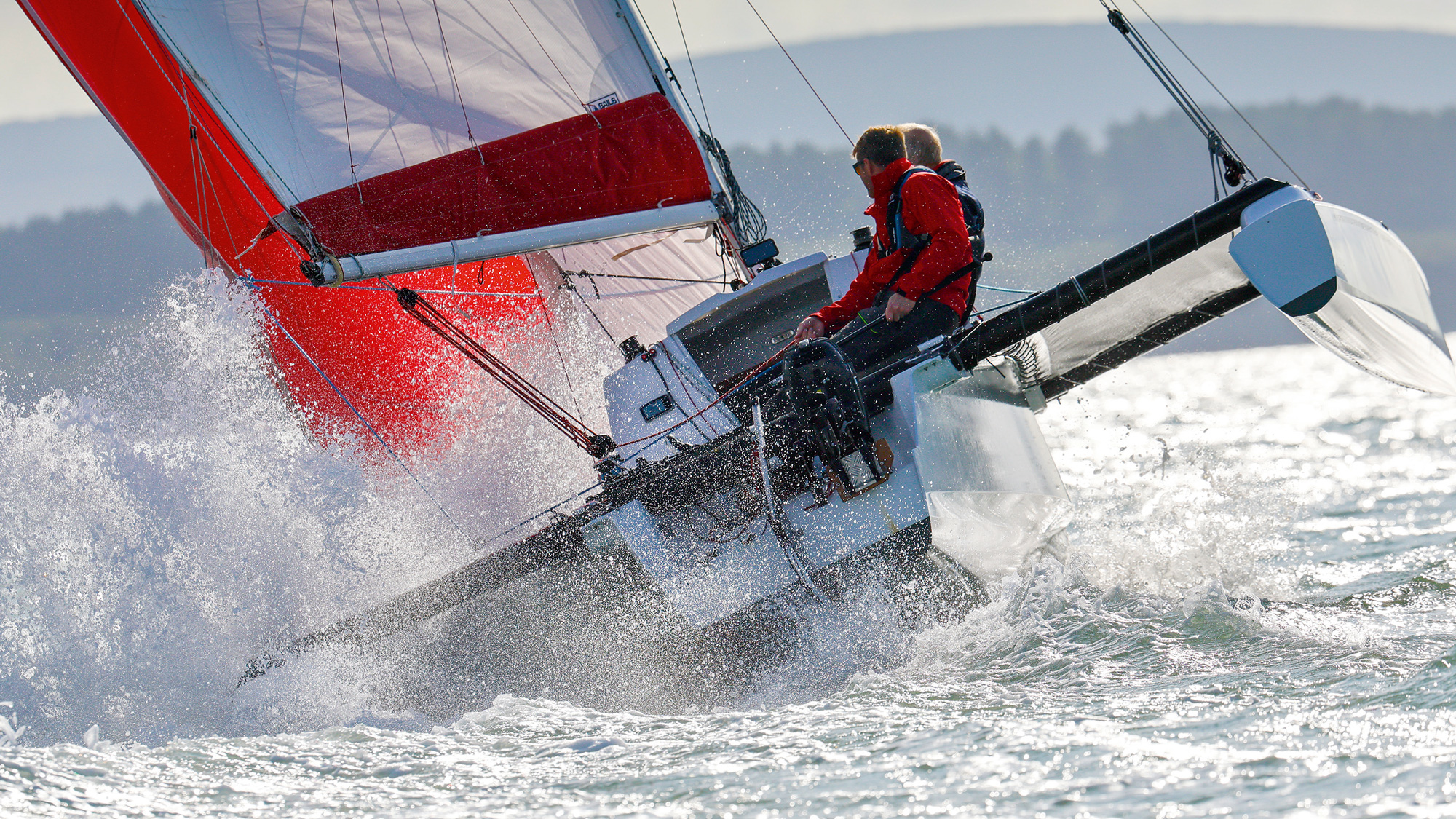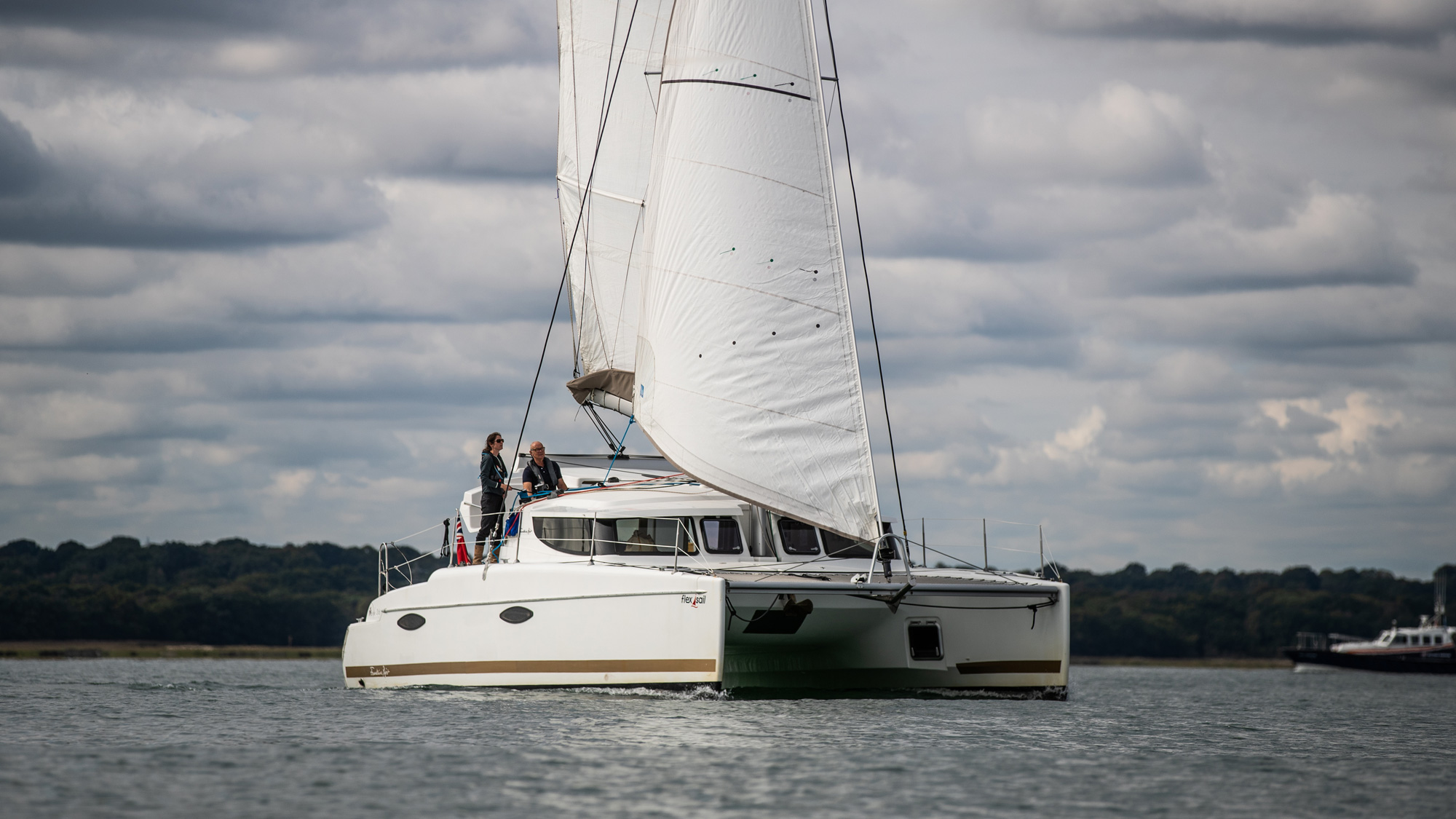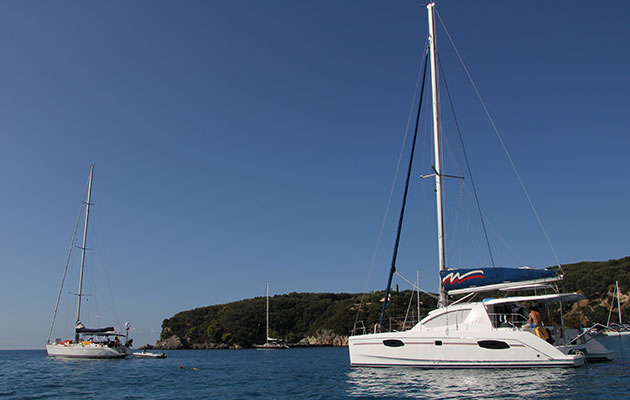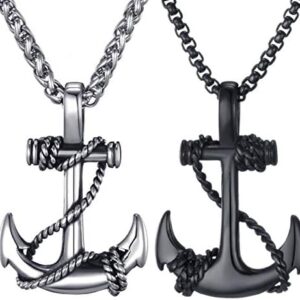People are inclined to gravitate into tribes of like-minded fans, having fun with the encouragement, assist and sense of identification, whereas usually trying askance at others; sailors at motorboaters, cruising sailors at racers, monohull sailors at raft, I imply, multihull sailors, and everybody seems to be askance at jet-skiers.
Massive cruising catamarans (40ft now counts as a small one) are a world other than monohull crusing, however there’s a sub-tribe of sailors devoted to life on three hulls and builders comparable to Dragonfly, Corsair, Farrier, and Astus give them loads of selection.
I’ve been crusing a 22ft (7m) Astus 22.5 this season, with simply sufficient house for a household of 4 and a minimal of creature comforts. Due to her VPLP-designed hulls and 650kg all-up weight, we will sail upwind at 7-plus knots and downwind at over 10 knots with ease, all on a roughly even keel, whereas the children play Duplo down under. It will also be beached and is towable behind a automobile.
Having, it appears, caught the trimaran bug, I wished to get higher at crusing and dealing with the boat, however my monohull crusing expertise and habits had been proving one thing of a hindrance, so we sought recommendation from some present trimaran homeowners, and properly because the UK’s prime multihull sailors.
A lot of the recommendation will apply to all multihulls, whether or not two or three-hulled, whereas different elements are only for small trimarans. I additionally discovered that brushing-up a few of my rusty dinghy crusing expertise helped get my head round what we had been attempting to do.
To check out our knowledgeable ideas we went out crusing to see what distinction they made. On the day, we obtained a stable Pressure 4-5 southwesterly, averaging 16 knots, however fluctuating between 12 and 20 knots true.
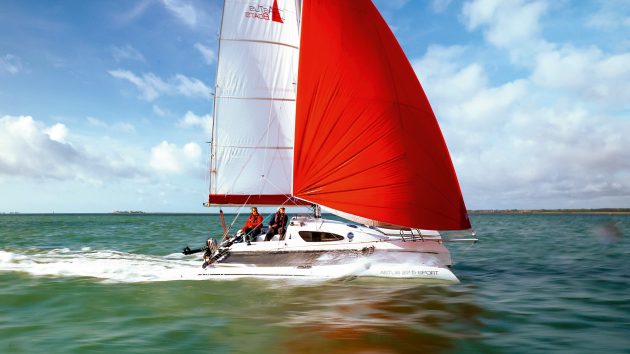
Blasting about on a sporty trimaran is an entire world of enjoyable, however is way calmer than it seems to be
Trimaran sail trim
One of many largest variations between a cruising monohull and a multihull is how the mainsail is trimmed. Leech rigidity on a yacht is commonly largely managed by the kicker and the backstay, whereas the mainsheet sheets the mainsail out and in, predominantly controlling the angle of the increase to the centreline, and there could also be a brief traveller.
On a mulithull, nonetheless, there’s greater than sufficient house for a superb, broad traveller. Those that sail on efficiency monohulls will even be used to this. The sail form is especially managed by the mainsheet, and the traveller then strikes the increase in the direction of or away from the centreline.
That is exaggerated on a multihull which has broad shrouds, swept properly aft with no backstay, making house for a robust square-top mainsail with full-length battens. There’s no backstay to bend the mast and flatten what’s anyway a fairly inflexible mainsail.
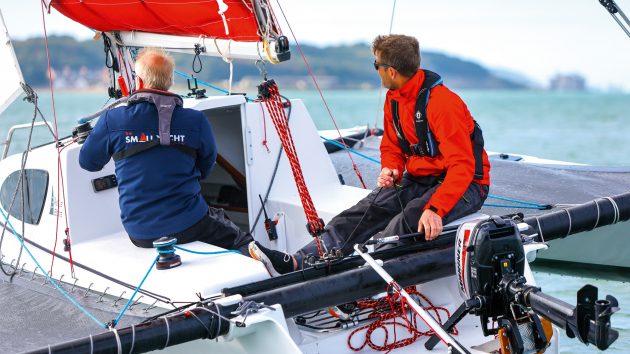
The mainsheet buy creates sufficient energy to regulate the leech of the square-top mainsail
Depowering a trimaran
Crusing on a monohull, heel and weatherhelm and ultimately a broach give a great deal of warning that you just’re pushing too onerous. With straight hulls and little heel, these warning indicators don’t actually apply to multihulls.
In actuality, nonetheless, there are a bunch of warning indicators that it’s time to back-off; they’re only a bit totally different. Even then, there’s nonetheless a big security margin earlier than you get near hazard.
By means of reassurance, with the boat powered up on a beat, Hein, from Boats on Wheels, the boat’s proprietor, stood on the leeward hull and lent on the shrouds. Whilst his toes obtained moist and the wind gusted on the prime of Pressure 4, the boat didn’t bat an eyelid, because of the large buoyancy of the floats.
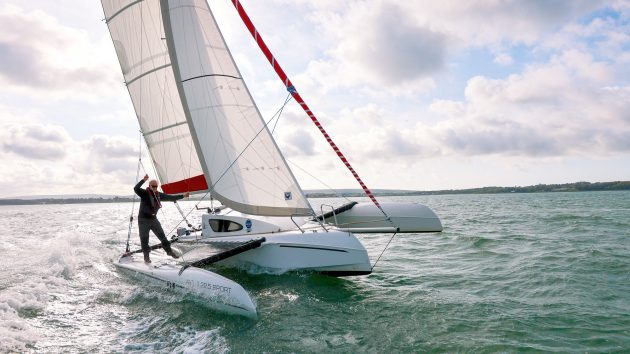
Even with an individual on the leeward float the boat was extraordinarily steady
On the water – sail trim
My first inclination was to level the boat as excessive upwind as attainable, pin the sails in and go for top. Doing that resulted in a not-terrible boat pace of 5-6 knots and a superb pointing angle.
Free off by a handful of levels nonetheless, and ease the sails only a smidge, and the pace leapt as much as 8-9 knots – over 50% extra; an enormous enhance. So, don’t pinch. Should you had a good chartplotter on board, you may discover your optimum pace to angle utilizing velocity made good (VMG).
I used to be additionally tempted to pinch within the gusts, however it’s higher to carry your course and let the pace enhance till the primary wants easing.

On the wind, it’s time to get the boat totally powered up
If that’s the case, drop the primary down the traveller an inch or two or ease some twist into the mainsail and it makes all of the distinction on this planet, however not up to now that the highest battens fall away and invert – that basically isn’t quick. Push too onerous and the boat will decelerate, largely from the drag of submerging the leeward float and crossbeams. Should you’re nonetheless overpowered and the primary is luffing, it’s time to reef. Downwind is totally different, however we’ll get onto that later.
After we put a reef in the primary, our boat speeds upwind remained largely the identical, and the boat was a lot happier. I got here away feeling reassured that even somewhat trimaran like this could be fairly troublesome to capsize, and there have been at all times loads of warning indicators telling me to take my foot off the pedal somewhat.
Article continues under…
How do you make a median passage pace of seven knots, slot in three double cabins and an enormous saloon…
As former editor of Yachting World, David Glenn has loads of expertise of each monohull and multihull cruising. Right here he…
Tacking and gybing a trimaran
Everybody is aware of that multihulls don’t tack in addition to monohulls. Straight hulls and broad beam don’t lend themselves to turning, particularly when coupled with the displacement and stuck keels of huge cats. Trimarans are somewhat simpler, with a single central daggerboard to behave as a pivot, and one or different of the floats will usually be away from the water. On the draw back, gentle displacement signifies that there isn’t a lot momentum to maintain you going by way of the flip and loads of windage to cease you.
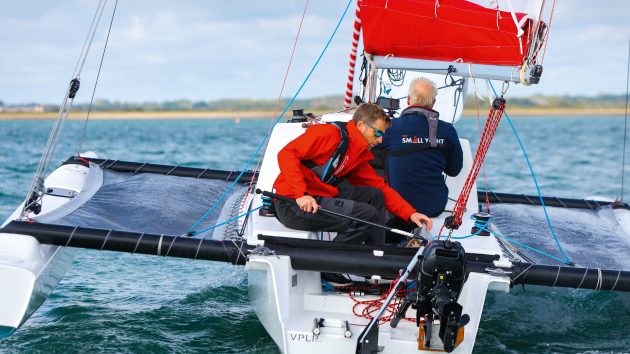
On a trimaran the central daggerboard helps the boat to show by offering a central pivot level that catamarans lack
Pace is your buddy. Construct pace up earlier than the tack to offer you as a lot momentum as attainable. The helm must steer positively into and thru the flip, and if essential, hold the jib backed on the brand new windward facet to assist the bow by way of the wind. Don’t fear about scrubbing pace off, however you don’t need to get caught in irons.
In relation to gybing, pace is once more key. The turning bit isn’t going to be a problem as you’ll be scooting alongside, however the quicker you’re going, the much less load there shall be on the sails. The extra you decelerate, the extra the true wind will pile up.
Trimaran crusing expertise
Tacks took a little bit of follow. It felt plain flawed to jab the tiller throughout the boat, slamming a giant break on within the water however I ended up placing us by way of the tacks far too slowly, dropping a number of pace. A extra aggressive method labored higher. On the Astus, the traveller was between me and the tiller, so the tiller extension wanted to be swung across the stern behind the mainsheet onto the brand new facet.
Equally, previous habits of controlling a gybe wanted to be modified. With the uneven set, we had been planing at properly over 10 knots, and the perfect is to remain on the airplane. Heading useless downwind and centring the primary result in a extra violent manoeuvre than flying into the gybe as quick as attainable and, because the increase was by no means that far out because of the obvious wind angle, it didn’t want a lot further controlling.
Arising onto the wind after the gybe helped the uneven across the entrance of the jib and to fill on the brand new facet. Keep too deep and it’ll get blanketed by the primary. As soon as we had constructed up some obvious wind, we may bear away once more.
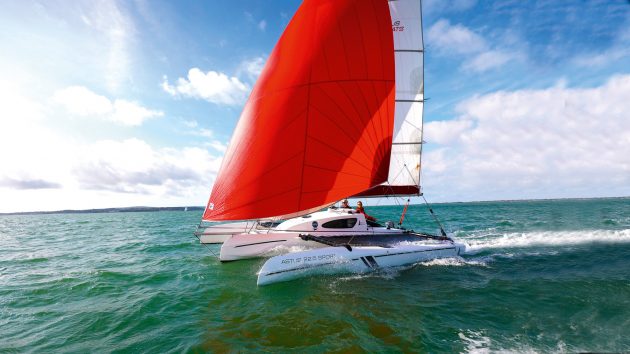
You’ll be on a course deep downwind earlier than you already know it, hitting speeds within the double digits
Downwind in a trimaran
Upwind cruising could also be enjoyable in a multihull, however bearing away and going with the wind is what it’s all about. Simply-driven hulls, a beneficiant sailplan and lightweight weight imply you could be up and planing, leaving displacement boats wallowing in your wake.
The massive distinction comes from obvious wind. Should you’re in a ship that may do 15 knots downwind in 20 knots of true wind, the ensuing wind angles can actually mess together with your head.
To get going then, says Brian Thompson, ‘Use these leech tell-tales once more when crusing downwind and reaching to set the proper twist by way of the mainsheet, and use the traveller to set the proper angle of the entire sail to the wind.’
Because the wind and your pace builds, bear away and trim the primary accordingly.
In idea, you shouldn’t must ease the traveller in any respect, however chances are you’ll must if you wish to sail deep downwind. Because the gust fades, you’ll discover the boat slows down, so you’ll be able to come again up in the direction of the wind somewhat to choose up some extra breeze, after which bear away as you speed up once more.

Bear away because the boat accelerates. Your course shall be one thing of a slalom as you look to maintain a constant wind angle
This leads to one thing of a ‘slalom’ course, and also will be accentuated in case you’re crusing down waves, however that’s all fairly regular for obvious wind crusing. Finally, you’re searching for a constant obvious wind angle, even when the ensuing wake isn’t straight.
It’s value remembering that obvious wind reduces the felt impact of the wind, so that you want a sailplan to swimsuit the true, not obvious wind pace.
I discovered that the boat was extra delicate to having a balanced sailplan and trim downwind than upwind, largely since you’ve obtained nearly double the canvas up, with the bowsprit as an additional lever. When climate helm constructed, I wanted to ease the mainsheet to extend twist to depower in order that I may bear away. I have to admit, getting the boat balanced, crusing quick and lightweight on the helm at 15 knots was one thing I got here away feeling I wanted extra follow at.
Reviewing the photographs, I think the uneven was sheeted in too onerous, with an excessive amount of twist in the primary.
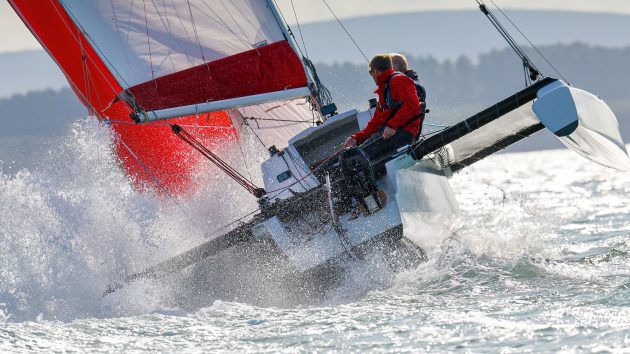
Getting a float totally submerged is when it’s time to again off
On the water
Unfurling the gennaker labored greatest on a beam attain, giving loads of airflow over the sail to assist it totally unfurl. This was additionally roughly the quickest level of sail, supreme for getting up some pace for obvious wind crusing. We largely had the sails set for an in depth attain, even after we had been past 120º off the true wind on a broad attain.
It was attainable to soak deeper downwind, however lose the obvious wind profit downwind and our pace dropped off dramatically, prompting us to level a bit larger to search out some extra pace.
Because the boat powered up, it paid to carry a barely larger angle than I’d have completed in a monohull for the boat to correctly take off and rise up into double digit speeds – topping out at 15 knots. Lymington to Cowes would have taken us simply half an hour at that pace. It’s straightforward to offer your self a heck of a beat again!
We had been crusing on a fairly flat day, so didn’t need to take care of any waves to talk of. On the current RTI that is what induced the capsizes of a minimum of two multis, a sobering reminder that you must sail far more conservatively in lumpier situations.
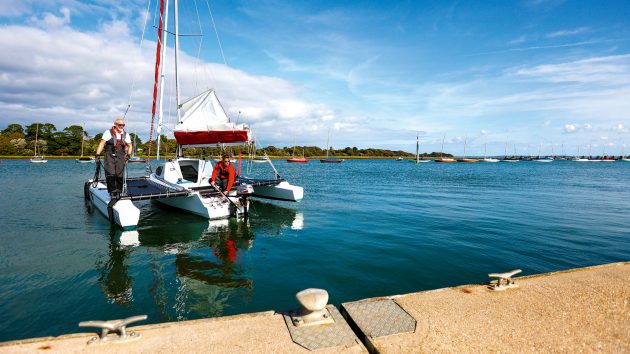
The bows need to level downwind, so a stern-first method works with relatively than towards the boat
Coming alongside
A 650kg boat with no draught and loads of windage feels dreadfully skittish when manoeuvring in confined areas. Straight hulls with no forgiving curves and fragile-looking sharp bows make berthing tough. You’ve obtained a few benefits in your facet, nonetheless. Within the Astus, the floats are at pontoon top making stepping off straightforward.
Whether or not you have got an engine in every hull of a cat, or one within the central hull of a tri, there’s additionally much more leverage to play with to show the boat and drive her on or off the pontoon. A steerable outboard provides you much more choices.
If the boat has a lifting keel or daggerboards, put them down if there’s sufficient depth to offer you a pivot and to withstand drifting. Take into consideration getting corners onto the pontoon, relatively than placing the boat alongside. On tris, you received’t have the ability to get to the bow to fend off because it’s too slim. You’ll be able to rig a fender up forwards on a line, and two fenders are sufficient on the flat sides.
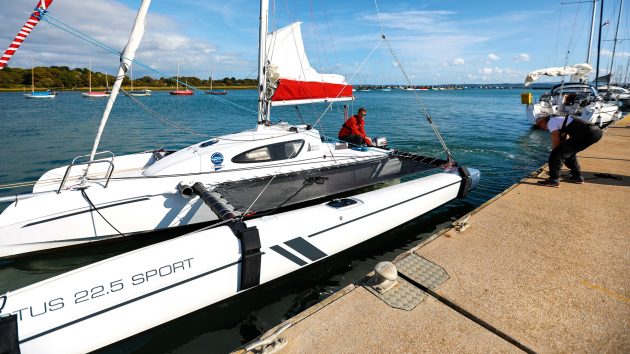
Steering with the outboard in the direction of the pontoon will drive the strict in additional; steer away to drive the bow in additional
Offshore wind
Coming onto the pontoon with wind blowing off, it labored properly coming in stern first. If there’s a tide operating, you’ll need to be heading into the tide, so discover a spot down wind and down tide to begin your method so that you are available in at an angle.
On our first try we had a little bit of tide underneath us to begin with so we got here in at a a lot steeper angle, nearly 90º, though this labored out OK in the long run.
The crew may then step ashore, taking a line from the strict quarter spherical a cleat.
Drive forwards towards the road and the bow will obediently drive up in the direction of the pontoon, bringing you flat alongside. Getting off was easy, releasing the bowline, and permitting the bow to swing out the earlier than slipping the strict line.

Coming in astern and stopping upwind of the berth meant the bows blew in the direction of the pontoon far to shortly
Onshore wind
Getting onto and off a pontoon with onshore wind proved relatively trickier. On our first try we got here in stern first. The problem was that after we had been simply upwind of our desired berth and stopped, we misplaced steering and the bow instantly blew off with alarming pace in the direction of the pontoon.
Going forward would solely enhance the power of the affect, whereas going astern solely elevated the bow’s sideways drift. I managed to again out with out smashing the bow, however solely simply, and ended up awkwardly stern to the wind with the bows pointing on the pontoon.
On our second try we got here in bows first however having aimed on the berth, I needed to motor the strict to leeward to cease the bow hitting, making for a relatively forceful coming alongside.
On take three, I got here in forwards and started ferry gliding in the direction of the berth early, holding the bows to windward of the strict. With the ability to steer with the outboard meant I may go forward to maintain the bow up, and go astern with the engine pulling the strict down towards the pontoon. On this approach, it was attainable to come back in fairly properly managed and parallel to the berth.
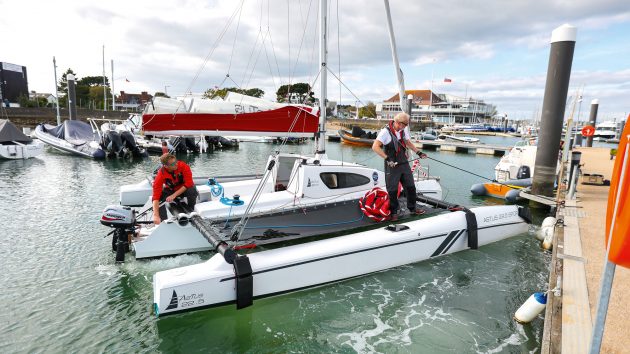
To get out, motoring astern towards a bow line pulled the whole boat clear earlier than slipping the road
Leaving was a special proposition all collectively, as I didn’t need to drag the bow alongside the pontoon, or to drive onerous onto it to spring off. As an alternative, we rigged a slip-line from the ahead cross beam. Going astern towards this, after which turning the engine in the direction of the wind, I may pull the strict, and the remainder of the boat, out and away from the pontoon.
Preserving energy on astern, as soon as we’d reached a good angle, we slipped the road and went astern, discovering steering approach nearly without delay, with the bow following obediently in our wake with extra management than I had anticipated.
Whether or not the wind is blowing onto, or off the pontoon, you need the engine to be driving or pulling the boat off the pontoon with a line on the nook you’re going away from. That approach you keep away from point-loading high quality ends the place it’s onerous to fender.
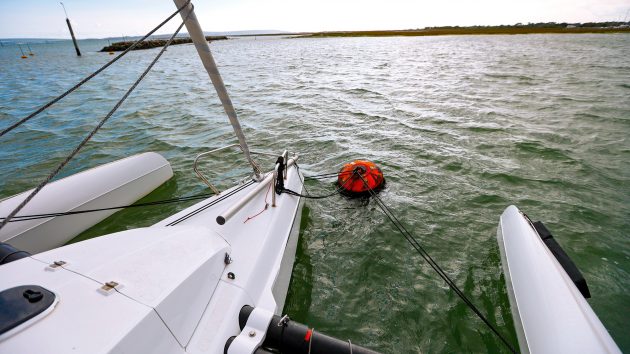
You’ll desire a bridle to cut back swinging, however hold the choose up strains on the bow as backup
Anchoring and mooring a trimaran
Whereas mooring a catamaran is difficult by the shortage of a central bow, issues ought to be less complicated on a trimaran, and they’re, largely. Choosing up a mooring buoy from the primary hull bow with a low freeboard and dropping the pick-up line onto a cleat is less complicated even than a monohull.
The bow could also be slim, however for any strains that move by way of a hoop on the buoy, you continue to must take it again to the identical cleat to keep away from chafe. That ought to be it, however windage from the 2 further bows and the shortage of keel imply the boat can dance merrily across the mooring buoy in a breeze.
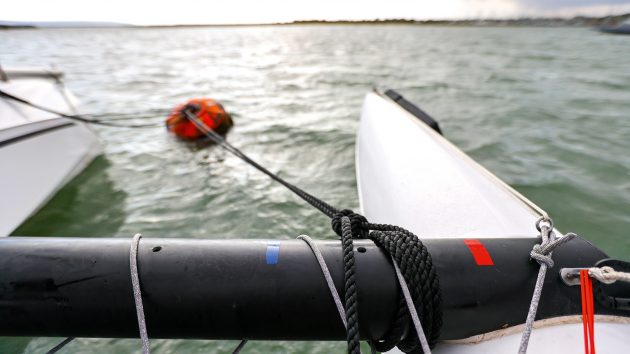
Rig the bridle so the buoy sits to at least one facet to stabilise the boat
On the water
In follow, we discovered {that a} trimaran advantages from a mooring bridle in the identical approach {that a} catamaran does. It could possibly’t be rigged from the floats’ bows, as there aren’t any mooring cleats, so a line handed across the outboard ends of the ahead beams gave a fairly good angle, once more with lengthy strains handed by way of the mooring and again to the identical facet. The primary pick-up strains keep as a security backup.
The opposite trick is to rig the bridle asymmetrically in order that the buoy sits to at least one facet or the opposite, simply sufficient to not be useless head to wind, making it far more steady within the wind.
On the plus facet, the shortage of draught or keel signifies that you’ll almost at all times be mendacity head to wind, so the cockpit stays good and sheltered regardless of the tide’s doing.
We ran out of time on the day to attempt anchoring, however rigging a bridle, successfully an extended snubber to a degree on the anchor chain in an identical approach wouldn’t be tough.
Should you wanted to not swing, or to behave extra like deeper boats close by, hanging a bucket over the strict can assist, or there’s at all times anchoring with a kedge, both out forward in a V, or in line astern.
Loved studying this?
A subscription to Yachting Month-to-month journal prices round 40% lower than the quilt value.
Print and digital editions are available through Magazines Direct – where you can also find the latest deals.
YM is filled with info that can assist you get essentially the most out of your time on the water.
-
-
- Take your seamanship to the following degree with ideas, recommendation and expertise from our consultants
- Neutral in-depth opinions of the most recent yachts and tools
- Cruising guides that can assist you attain these dream locations
-
Observe us on Facebook, Twitter and Instagram.

